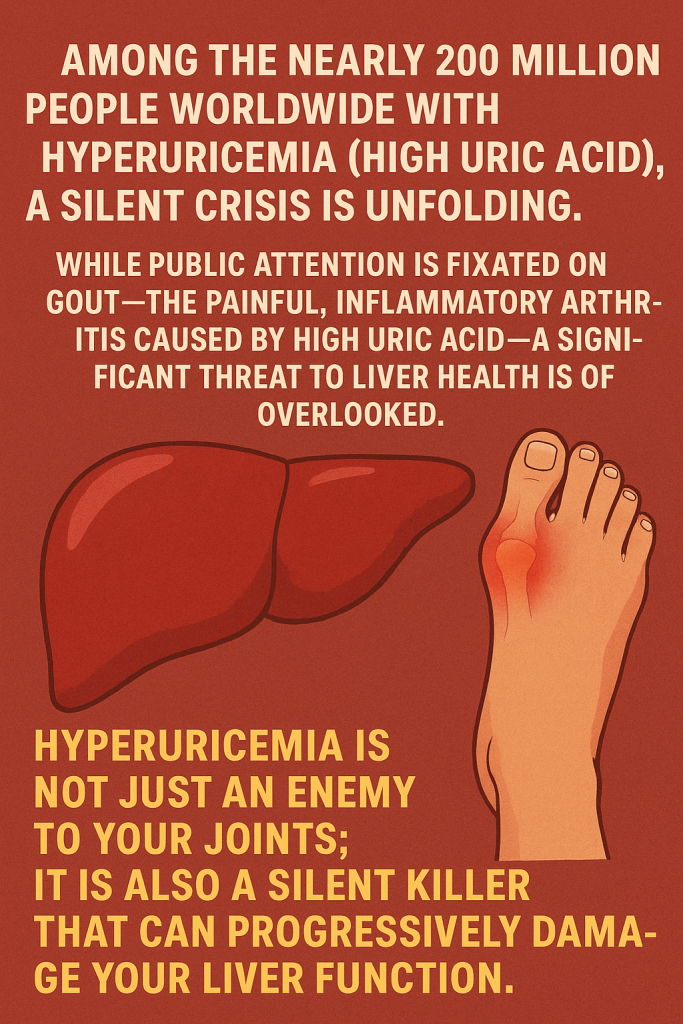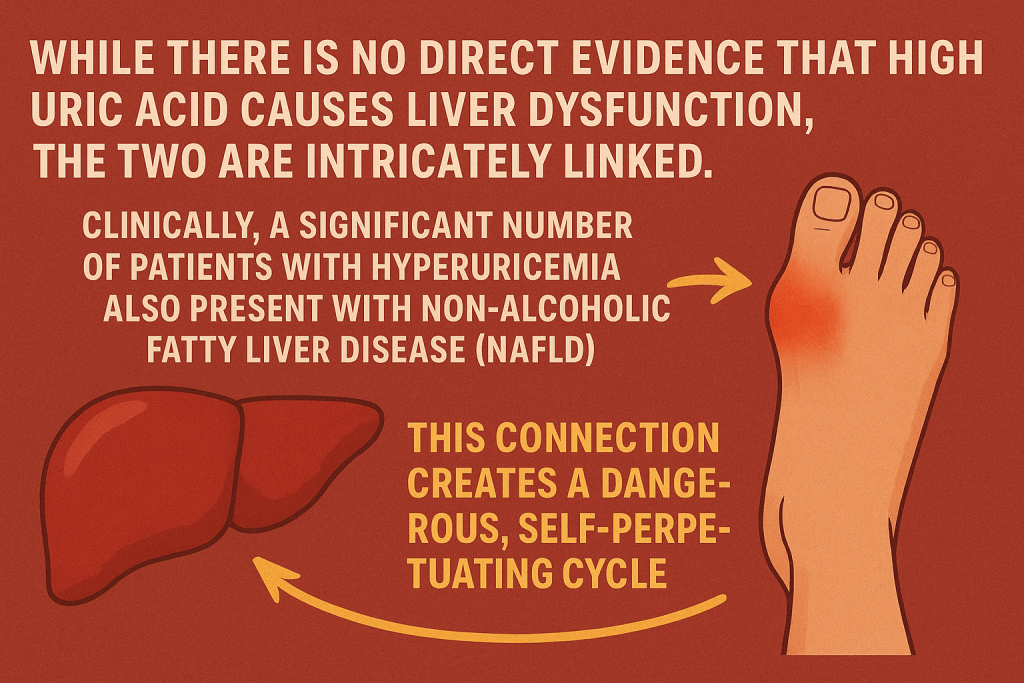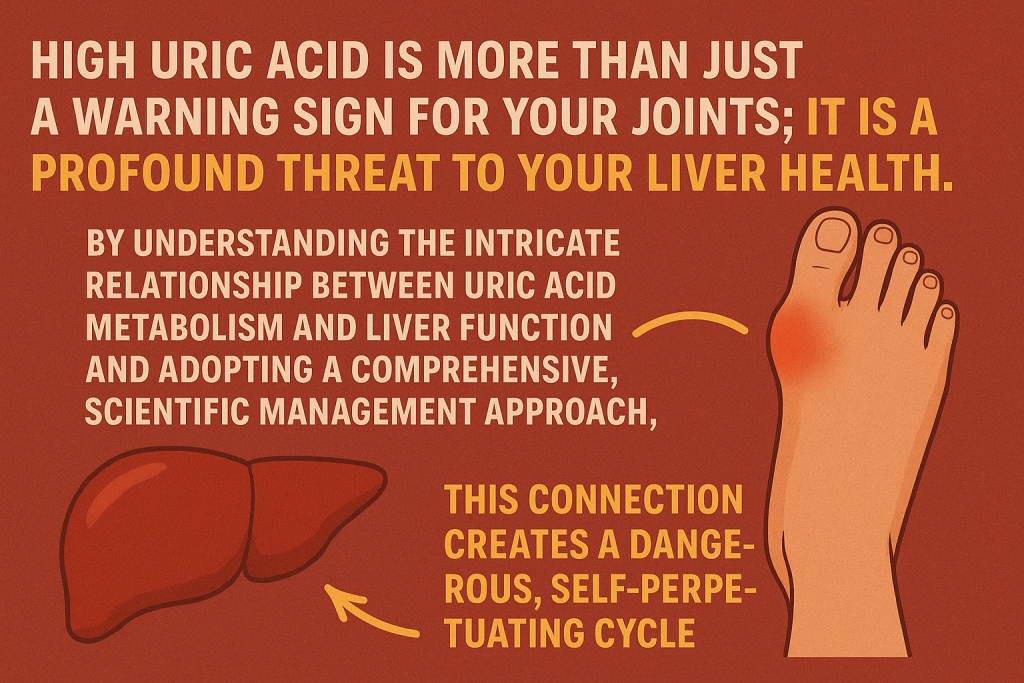Introduction: A Crisis Hiding in Plain Sight
Among the nearly 200 million people worldwide with hyperuricemia (high uric acid), a silent crisis is unfolding. While public attention is fixated on gout—the painful, inflammatory arthritis caused by high uric acid—a significant threat to liver health is often overlooked. Hyperuricemia is not just an enemy to your joints; it is also a silent killer that can progressively damage your liver function.

The Liver: The Central Hub of Purine Metabolism
Uric acid is the final breakdown product of purines in the body. The liver is the central hub where this metabolic process takes place. Approximately 80% of the body’s purines are endogenous, created from the natural breakdown of our own cells, while the remaining 20% come from dietary sources. Regardless of their origin, all purines are ultimately processed in the liver through a series of complex enzymatic reactions to produce uric acid. Therefore, the health of your liver is directly linked to the stability of your body’s uric acid levels.
The Vicious Cycle of High Uric Acid and Liver Disease
While there is no direct evidence that high uric acid causes liver dysfunction, the two are intricately linked. Clinically, a significant number of patients with hyperuricemia also present with Non-Alcoholic Fatty Liver Disease (NAFLD). This connection creates a dangerous, self-perpetuating cycle:

- Severe fatty liver disease can impair liver function.
- An impaired liver struggles to metabolize purines efficiently.
- This metabolic disruption can further elevate uric acid levels, worsening the hyperuricemia.
Furthermore, hyperuricemia is a metabolic disease that often shares common root causes with NAFLD, including obesity and insulin resistance. This “shared soil” means that high uric acid and fatty liver disease often develop hand-in-hand, signaling a deeper, system-wide metabolic disorder.
The Hidden Liver Risks of Gout Medications
The treatment of high uric acid and gout requires caution, as several commonly prescribed medications can pose a risk to the liver.
- NSAIDs (Nonsteroidal Anti-inflammatory Drugs): Used to manage the acute pain of a gout attack, long-term or improper use of NSAIDs can lead to drug-induced liver injury.
- Urate-Lowering Drugs:
- Allopurinol: Can cause side effects ranging from skin rashes to severe liver and kidney damage.
- Febuxostat: Carries a controversial cardiovascular risk, leading to a “black box warning” in the U.S., Canada, and its country of origin, Japan.
- Benzbromarone: Due to its severe hepatotoxicity, this drug has been withdrawn from the market in the European Union. One report noted that medications containing this ingredient were linked to six deaths over a three-year period.
- Colchicine: While a long-standing medication for relieving gout symptoms, colchicine can also cause adverse effects like liver cell damage, especially in patients with pre-existing liver or kidney insufficiency.
Given these risks, patients should undergo regular liver function tests before and during treatment. This allows physicians to monitor for any adverse effects and adjust the treatment plan accordingly to prevent drug-induced liver injury.
Comprehensive Management: Balancing Liver Health and Uric Acid
Facing the dual challenge of high uric acid and potential liver damage, a comprehensive health management strategy is essential.
- Proactive, Scientific Management is Key: Work with a healthcare professional to create a long-term management plan that includes regular monitoring of both uric acid levels and liver/kidney function.
- Adhere to Medication Guidelines: Never alter your medication dosage or stop treatment on your own. Always follow your doctor’s instructions and be vigilant about potential side effects on the liver.
- Adopt a Healthy Lifestyle: While diet alone cannot cure high uric acid, combining a balanced diet with regular exercise and maintaining a healthy weight is crucial for improving your overall metabolic health and reducing the burden on your liver.
- Manage Comorbidities: High uric acid often coexists with other metabolic diseases. Actively treating these underlying conditions is a critical part of protecting your long-term liver function.
Conclusion

High uric acid is more than just a warning sign for your joints; it is a profound threat to your liver health. By understanding the intricate relationship between uric acid metabolism and liver function and adopting a comprehensive, scientific management approach, you can effectively mitigate these risks and safeguard your long-term well-being.
